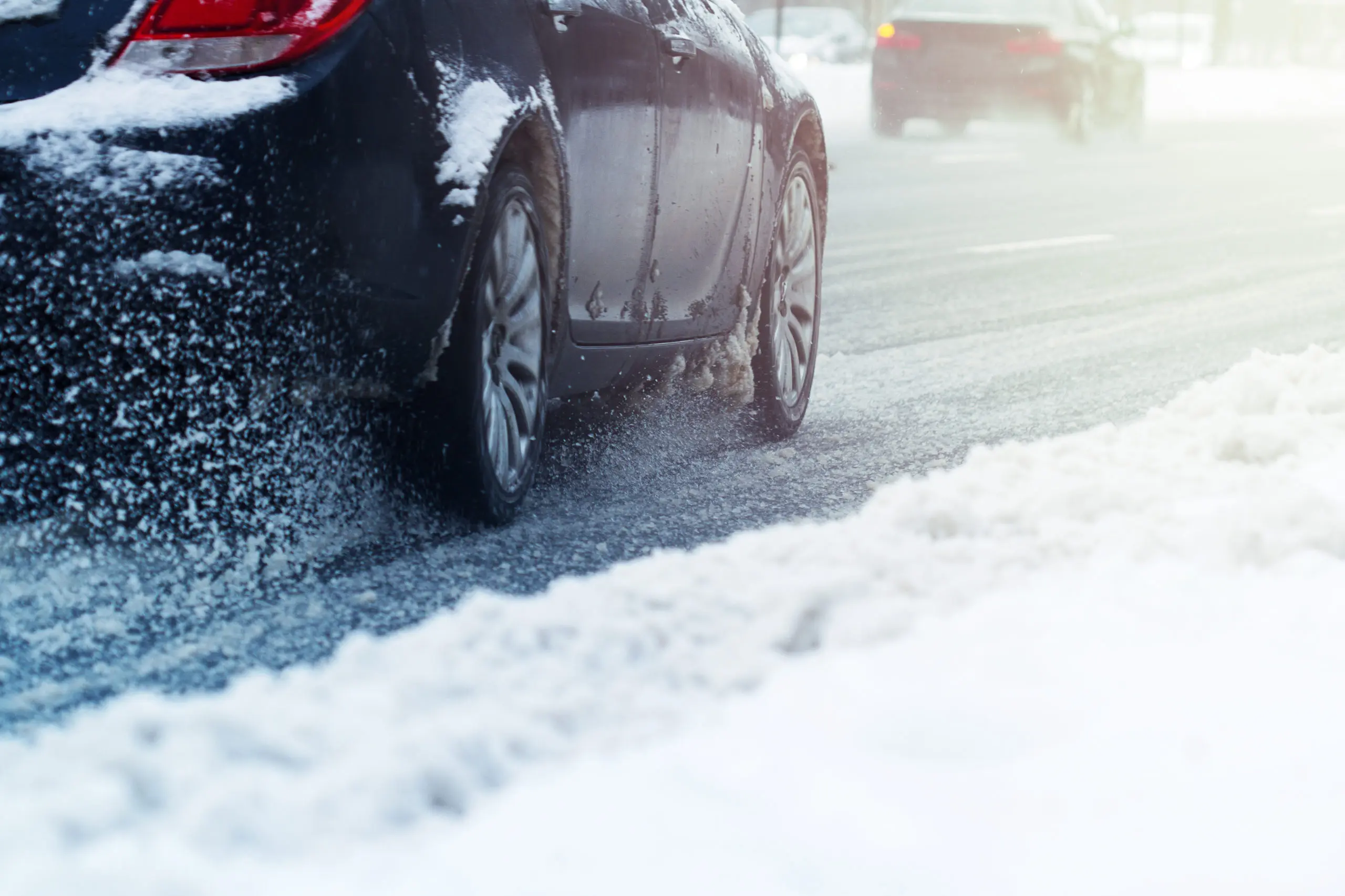Tips for Driving in the Snow
There’s no question that winter weather creates some hazardous driving conditions. Although staying off the roads when snow or ice hits is recommended, there will always be situations when not driving is not an option. In those times when winter driving is necessary, it’s essential to take the necessary steps and precautions to ensure you can do so safely – and are prepared for almost any situation. From having the right items in your vehicle to ensuring all necessary maintenance is up-to-date on your vehicle and everything in between, make sure you practice safe driving all winter.
Ensure Vehicle and Roadway Safety
There are several steps you should take with your vehicle, as well as things that will help you stay more aware of your surroundings to ensure you have the safest driving experience on snow-covered roads. Be prepared, keep yourself safe, and help protect those around you with these winter driving tips.
1. Remove Any Snow and Ice from Your Vehicle
If your vehicle is regularly parked outside, removing all snow and ice before driving anywhere is essential. Yes, it is vital to see out of your windows, but leaving snow piled on your vehicle’s hood, top, or trunk can lead to problems for you and other drivers. The excess snow and ice can blow off your vehicle and into the roadway, fly off in frozen chunks and damage other vehicles, or blow up into your windshield, lowering visibility. In some states and locations, leaving excess snow and ice on your vehicle could be considered negligent driving, so it’s always best to remove as much snow and ice as possible.
2. Drive Slow and Minimize Distractions
Driving slow on icy roads or in any less-than-ideal weather conditions is essential. Your vehicle will handle differently in inclement weather – visibility may be lower, your braking distance will be longer, tire traction will be lower, and more. Because of these more dangerous driving conditions, you’ll want to minimize or remove any driving distractions. Keeping both hands on the steering wheel and your eyes on the road is necessary whenever you drive a vehicle, and it becomes even more critical on snowy roads.
3. Keep Your Gas Tank Full
Throughout the year, you may feel comfortable driving until your gas gauge gets near the E, but in winter, you’ll want to keep your tank a bit more full at all times. In inclement weather, traffic will move slower, meaning it will take longer to reach your destination. If you don’t have enough gas, you risk emptying the tank, leaving you stranded on the side of the road in dangerous conditions.
4. Respect the Snowplows
If you find yourself on snow-covered roads with snowplows, you must give them the respect and space they need to do their job. It can be frustrating when you get behind them, especially on a highway, but they do what’s necessary to clear the roads safely and completely. Keep your distance so salt or road treatments do not spray up on your vehicle. If necessary, move out of the way or over to allow extra room for them to work. Also, never try to pass snowplows, particularly when several are staggered across a highway; this puts you and the plow drivers at risk of an accident, causing further road delays and potentially serious injury.
5. Get New Windshield Wipers and Top Off the Wiper Fluid
Vehicle windows often become quite messy during winter as water from melting snow and ice mixed with salt or other treatments sprays up from vehicles in front of you and from your tires. Old windshield wipers can make this mess worse, lowering your ability to see clearly. Plus, because of this mess, you probably use your wiper fluid more to help clear the windshield. Ensure you have less chance of losing visibility by replacing your old or worn wipers and topping off the wiper fluid for the season (and regularly check the fluid levels depending on use).
6. Keep the Cruise Control Off
Cruise control keeps you at a constant speed, which is great for highway driving but was designed to be used in better driving conditions. In inclement weather conditions, it could be dangerous. If your vehicle begins to lose traction and slip, a point at which you should be releasing the gas, your vehicle may end up trying to speed up. Sticking with just your foot on the gas will help you regulate the speed for the conditions and keep your foot closer to the brake pedal, giving you better control if you hit a slick spot or tighter curve.
7. Carry Emergency Supplies
We never want to think about getting stranded on the road, but it’s always possible, especially in winter. There should always be an emergency first-aid and roadside safety kit in your vehicle, but during winter, you should keep items that could help you stay warm and comfortable while you wait for assistance, such as a warm blanket, gloves, hat, hand warmers, and more.
Consider packing some snacks if traffic gets particularly backed up in your area. In the event you get stuck in a parking spot or after sliding off a shoulder, some materials can help your vehicle regain traction to get back on the road. Spreading clean kitty litter or laying down your vehicle’s floor mats near the wheels can provide a surface with more friction for your tires to grip, helping your vehicle roll out of a slippery spot.
8. Check Tire Treads and Pressure
Ensuring your tires have a good tread level and the proper tire pressure will help provide better traction in wintery driving conditions. For those who find themselves driving quite often in snowy weather or on icy roads, consider investing in winter tires or uniquely designed snow tires for your vehicle. Snow tires are designed to provide better traction on winter roads when you’re on the gas or brake pedal than traditional and all-weather tires. An expert technician like ours at Telle Tire can help you find and install the correct winter tires to fit your vehicle.
Additional Tips For Driving In The Snow
There’s more to know about how winter affects your vehicle than just making driving more dangerous. Below, we’ve answered some of drivers’ most frequently asked questions regarding driving in below-freezing temperatures.
When is it Too Cold to Drive?
In general, vehicles are built to withstand extreme temperatures. However, the engine, battery, and fuel lines will take the most damage from bitterly cold weather. Granted, things aren’t going to freeze solid unless you’re driving around in -100 degrees Fahrenheit temperatures, but you may start noticing vehicle performance issues in just 32 degrees Fahrenheit, depending on your vehicle’s age and condition. Our winter maintenance checklist ensures your vehicle is prepared to handle the cold weather.
Do Freezing Temperatures Hurt Engine Performance?
Yes, freezing temperatures can end up hurting engine performance. When the vehicle battery becomes cold, it cannot produce the same level of power as it does when warmer. This will make it more difficult for the vehicle’s electrical system to get the power it needs to turn on. The frigid temperatures may also cause engine oil to become thicker, resulting in a lower ability to move around as needed. In some rare cases, moisture can get into the fuel lines. If that does occur, the cold temperatures can result in the moisture freezing and blocking fuel flow to the engine.
How Long Should I Have My Car Run Before Driving in Cold Weather?
People generally like to go out to the car before driving anywhere in winter and letting it warm up. However, contrary to popular belief, the only thing this is good for is warming up the interior – it does not help the engine run any better. Your vehicle’s engine will perform better when driving rather than sitting idle ahead of time.
How Do You Safely Navigate Icy Roads?
Ice can quickly accumulate on roads, so it’s essential to understand how to stay as safe as possible if caught in it while out and about. First and foremost, if your vehicle has the capability, shift into four-wheel drive, as it will help improve your traction and control. Whether all-wheel-drive or not, take your time; arriving late to your destination is better than getting into an accident or worse.
Driving on ice is tricky because you can move without issue one minute and feel your vehicle sliding off the road the next. Keep your distance behind and around any other vehicles to avoid having to slam your foot down on the brake pedal. If anyone brakes or begins sliding, you give yourself more time to react and remain in control until you regain traction if your vehicle also begins sliding. Drivers often believe that having antilock brakes is a safety feature for all weather conditions, but these do not work well on ice, and the wheels can still lock up, resulting in a loss of control. Regardless of the type of braking system you have, always keep your distance from other vehicles in winter.
Stay Safe in All Winter Driving Conditions with Telle Tire
We aim to keep your vehicle safe throughout the winter and year. Using these winter driving tips for safe driving in the snowy and icy conditions will ensure you and others arrive at your destinations without incident. Come to Telle Tire to check your engine health and the condition of your tires, find the right snow tires for your vehicle, and more. Visit your local auto service shop around St. Louis or Kansas City today, or contact an expert to answer your vehicle maintenance needs.


